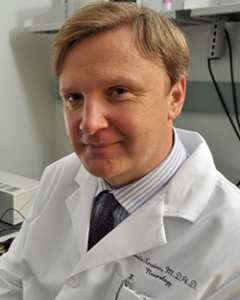
Northwestern Medicine scientists have used patient-derived neurons to develop and test a new strategy to treat Parkinson’s disease by mitigating the effects of harmful genetic mutations, as detailed in a study published in Science Translational Medicine.
Some experimental treatments for genetic disorders target mutated proteins or enzymes, but this study, led by Dimitri Krainc, MD, PhD, chair and Aaron Montgomery Ward Professor of Neurology, took a different approach. Instead of trying to fix broken enzymes, the scientists amplified healthy ones — an approach that successfully alleviated symptoms of Parkinson’s disease (PD) in human brain cells and in mouse models.
“This study highlights wild-type GCase activation as a potential therapeutic target for multiple forms of Parkinson’s disease,” said Krainc, who is also director of the Center for Neurogenetics.
Lena Burbulla, PhD, research assistant professor of Neurology in the Division of Movement Disorders, was the first author of the study.
PD is the second-most common neurodegenerative disorder, predominately affecting neurons in an area of the brain called the substantia nigra. These neurons are responsible for producing dopamine — a chemical messenger used to transmit signals throughout the brain — and for relaying messages that plan and control body movement.
Mutations in the gene GBA1 represent the most common genetic risk factor for PD, according to the study, and GBA1 codes for an enzyme called glucocerebrosidase (GCase) that is important for neuronal function. PD-associated mutations can disable GBA1 and produce misshapen GCase enzymes, which contribute to an accumulation of toxic proteins in dopamine-producing neurons.
As this neuronal population dies, patients experience symptoms such as tremors and slowness of movement. While some medications can offer relief for these symptoms, there is no treatment that can stop or slow the disease.
According to Krainc, drug development for patients with GBA1-linked Parkinson’s has largely focused on stabilizing mutated GCase and limiting its harmful effects. However, these treatments would be effective only in a few types of PD.
“Instead, activating wild-type GCase may be more relevant for multiple forms of PD that exhibit reduced activity of wild-type GCase,” Krainc said.
In the current study, scientists developed a new series of chemical activators that stabilized and amplified normal GCase. The activator, a small molecule that binds to GCase, improved PD-related cellular dysfunction in patient derived neurons.
Importantly, these modulators worked in several varieties of PD, showing this strategy could work for a wide range of patients, Krainc said.
“Our work points to the potential for modulating wild-type GCase activity and protein levels in both genetic and idiopathic forms of PD, and highlights the importance of personalized or precision neurology in development of novel therapies,” he said.
A 2017 study led by Krainc and published in Science found that some of the key pathological features of PD were only seen in human neurons and not in mouse models, further emphasizing the value of patient-derived neurons for drug development in Parkinson’s disease.
“It will be important to examine human neurons to test any candidate therapeutic interventions that target midbrain dopaminergic neurons in PD,” Krainc said.
This work was supported by National Institutes of Health (NIH) grants R01NS076054 and R01NS096240; WildKat; Buckeye Research LLC; The Michael J. Fox Foundation for Parkinson’s Research Grant 13881; and in part by NIH core support Grant P30 NS081774.






